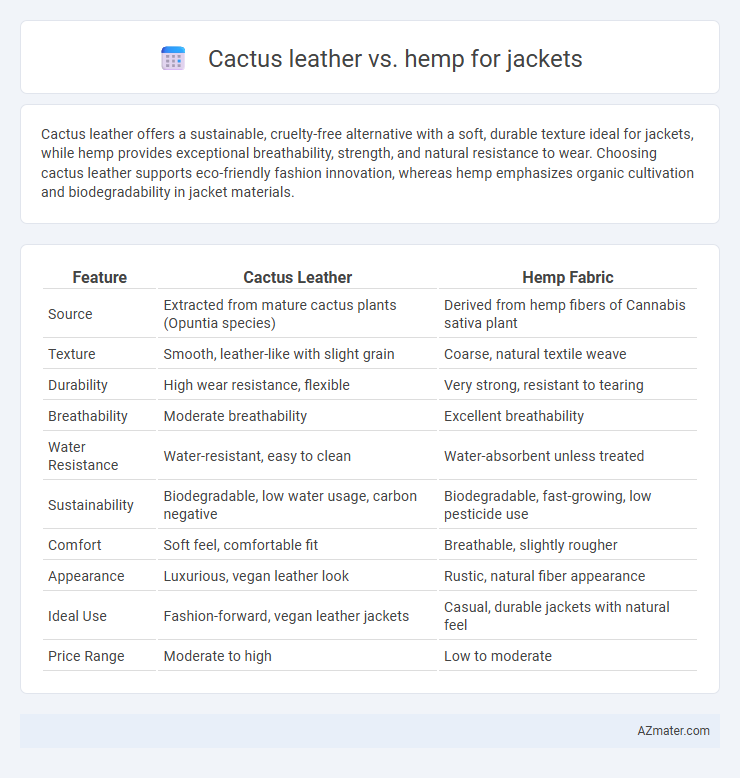Cactus leather offers a sustainable, cruelty-free alternative with a soft, durable texture ideal for jackets, while hemp provides exceptional breathability, strength, and natural resistance to wear. Choosing cactus leather supports eco-friendly fashion innovation, whereas hemp emphasizes organic cultivation and biodegradability in jacket materials.
Table of Comparison
| Feature | Cactus Leather | Hemp Fabric |
|---|---|---|
| Source | Extracted from mature cactus plants (Opuntia species) | Derived from hemp fibers of Cannabis sativa plant |
| Texture | Smooth, leather-like with slight grain | Coarse, natural textile weave |
| Durability | High wear resistance, flexible | Very strong, resistant to tearing |
| Breathability | Moderate breathability | Excellent breathability |
| Water Resistance | Water-resistant, easy to clean | Water-absorbent unless treated |
| Sustainability | Biodegradable, low water usage, carbon negative | Biodegradable, fast-growing, low pesticide use |
| Comfort | Soft feel, comfortable fit | Breathable, slightly rougher |
| Appearance | Luxurious, vegan leather look | Rustic, natural fiber appearance |
| Ideal Use | Fashion-forward, vegan leather jackets | Casual, durable jackets with natural feel |
| Price Range | Moderate to high | Low to moderate |
Introduction to Eco-Friendly Jacket Materials
Cactus leather and hemp are innovative, sustainable materials transforming eco-friendly jacket production by reducing reliance on traditional animal leather and synthetic fabrics. Cactus leather, made from mature Nopal cactus leaves, offers a biodegradable, cruelty-free alternative with a soft, durable texture, while hemp provides exceptional breathability, moisture-wicking properties, and is one of the most renewable fibers with minimal environmental impact. Both materials contribute significantly to lowering carbon footprints and promoting ethical fashion choices in outerwear.
What is Cactus Leather?
Cactus leather is an innovative, sustainable material made from the mature leaves of the nopal cactus, processed into a durable, vegan leather alternative ideal for jackets. This eco-friendly fabric offers breathability, water resistance, and a natural texture, making it a popular choice compared to hemp, which is a natural fiber known for strength but lacks the leather-like finish of cactus leather. The production of cactus leather involves minimal water usage and generates less environmental impact, highlighting its advantage over traditional and hemp materials in sustainable fashion.
What is Hemp Fabric?
Hemp fabric is a sustainable textile made from the fibers of the Cannabis sativa plant, known for its durability, breathability, and eco-friendly properties. Compared to cactus leather, hemp offers a natural, biodegradable alternative with superior moisture-wicking capabilities and resistance to UV light and mold. Its lightweight and antimicrobial characteristics make hemp fabric an excellent choice for jackets that combine comfort with environmental responsibility.
Sustainability: Cactus Leather vs Hemp
Cactus leather and hemp both offer sustainable alternatives to traditional animal leather and synthetic fabrics for jackets. Cactus leather is derived from the mature leaves of the prickly pear cactus, requiring minimal water and no pesticides, making it highly eco-friendly. Hemp fabric is biodegradable, grows quickly with little water, and enriches soil quality, positioning both materials as strong contenders in sustainable fashion.
Durability and Longevity Comparison
Cactus leather offers superior durability with its natural resistance to scratches and water, maintaining its texture and appearance over time, making it an excellent choice for long-lasting jackets. Hemp fabric, while highly durable due to its strong fibers and abrasion resistance, can be more susceptible to wear and tear under heavy use compared to cactus leather. Both materials provide sustainable alternatives, but cactus leather generally outperforms hemp in terms of longevity and resistance to environmental damage for outerwear.
Comfort and Wearability Factors
Cactus leather offers a smooth, flexible texture that enhances comfort and allows better breathability compared to traditional synthetic options, making it ideal for jacket wearability in varying climates. Hemp fabric provides excellent durability and a natural, breathable feel, though it can be stiffer initially, requiring a break-in period for optimal comfort. Both materials promote sustainability, but cactus leather's lightweight, pliable nature often results in superior comfort for long-term wear.
Aesthetic Appeal and Style Differences
Cactus leather offers a sleek, smooth texture with a modern, matte finish that closely resembles traditional animal leather, making it ideal for contemporary and sophisticated jacket designs. Hemp fabric, on the other hand, presents a more rustic, coarse texture with natural variations that convey an earthy, bohemian aesthetic often preferred in casual and eco-conscious fashion. The stark contrast between cactus leather's refined appearance and hemp's organic, woven look highlights their distinct style appeals in jacket design.
Production Process and Environmental Impact
Cactus leather is produced by harvesting mature cactus leaves, drying, and grinding them into a bio-based material combined with non-toxic polyurethane, resulting in a sustainable alternative with minimal water use and zero pesticides. Hemp for jackets involves cultivating fast-growing hemp plants that require low water, no pesticides, and enrich soil health, with fibers processed through retting, decortication, and weaving into durable fabric. Both materials reduce environmental impact compared to traditional leather by lowering carbon emissions, water consumption, and chemical use, yet cactus leather offers a more direct animal-free substitute with a lower water footprint, while hemp jackets emphasize renewable textile cultivation and biodegradability.
Price and Availability on the Market
Cactus leather generally commands a higher price than hemp due to its innovative production process and luxury positioning, often ranging between $50 to $150 per square foot. Hemp is more widely available and cost-effective, typically priced around $20 to $50 per square foot, benefiting from established cultivation and manufacturing infrastructure. Market accessibility for hemp jackets is broader, whereas cactus leather remains limited to niche or premium brands.
Which Material is Best for Jackets?
Cactus leather offers a sustainable and cruelty-free alternative with a soft, supple texture similar to traditional leather, making it ideal for high-end jackets. Hemp provides exceptional durability, breathability, and natural moisture-wicking properties, suitable for rugged, eco-friendly outerwear. Choosing the best material depends on whether you prioritize luxury aesthetics and vegan leather qualities (cactus leather) or robustness and natural fiber advantages (hemp).

Infographic: Cactus leather vs Hemp for Jacket
 azmater.com
azmater.com